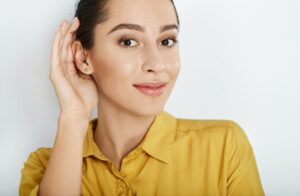Our bodies are not perfectly balanced in their abilities – your eyes probably see a little bit differently, and your feet aren’t the same size.
Similarly, your hearing loss affects each ear differently. You usually favour your left or right ear and hear better from one of them. But just because you can hear a little better in one ear doesn’t mean you can hear clearly in that ear. Your ‘good’ ear might not seem too bad compared to your ‘bad’ ear, but if we gave you a hearing test, we would find out exactly what sounds you can and can’t hear in each ear and probably show you that even your good ear has hearing loss.
That’s why we recommend that people with hearing loss in both ears should wear two hearing aids.
Here are a few reasons why.
Benefit #1: You’ll find it easier to figure out where a sound is coming from. If you only have one hearing aid, most sounds will sound like they are coming from the side you wear the hearing aid on. If you wear two hearing aids, it will probably be easier for you to figure out where sounds come from.
Benefit #2: You don’t need as much volume with two hearing aids. You can turn the volume down when you wear two hearing aids and still hear well. When you only have one hearing aid, you often raise the volume to a too-loud level. This is one reason why people wearing hearing aids often say everything sounds too loud. Keeping the volume low also helps prevent further damage to your hearing.
Benefit #3: Mask tinnitus better. If you have ringing in your ears (tinnitus), using two hearing aids can help. Hearing aids are often suggested to treat tinnitus, but a single hearing aid won’t cover up the ringing sound in an unaided ear.
Benefit #4: Enjoy better understanding in groups or when there is noise in the background. When you wear two hearing aids, your brain gets twice as much information, which it can use to “filter out” sounds you don’t want to hear and focus on the person you want to understand.
Benefit #5: Avoid ‘Auditory Deprivation’. If you only use one hearing aid when you need to, you may lose the ability to understand words in the other ear over time. Even though you might still be able to hear, it might be harder for you to understand what people say. When you wear two hearing aids, your whole hearing system stays active, which keeps you from losing your hearing.
Benefit #6: Enjoy a more balanced sound. If you can hear well out of both ears, you will feel more balanced than if you can only hear well out of one ear.
Benefit #7: Take full advantage of the latest features. Modern hearing aid technology is designed to function as a pair, just like your ears do. The two hearing aids communicate with one another using cutting-edge features like artificial intelligence to decide which sounds to amplify and focus on, much like your brain.
When is one hearing aid enough?
There’s only one situation where a single hearing aid is best, and that’s if you still have perfect hearing in one ear. If only one of your ears has hearing loss, you might be best off with just one hearing aid, but you should talk to a hearing professional about it (having one better ear is not the same as having one perfect ear).
However, most people experience hearing loss in both ears, mainly if it is age-related. (Even if one of your ears is better than the other, they are likely to be close in hearing levels.) In that case, research and experience indicate that two hearing aids will ultimately make you more satisfied.
Two hearing aids are better than one.
Too many good things come from being able to hear as well as possible from both ears to ignore. So, yes, two hearing aids are often better than one (just like two ears are better than one). Most of the time, though, having two hearing aids will be better for your ears and hearing than having just one.
If you’re ready to experience the benefits of two hearing aids, book an appointment with us today!

